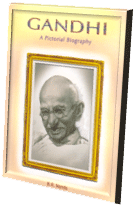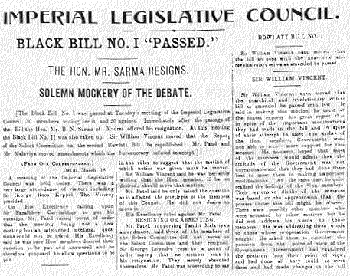
P.O. SEVAGRAM, DIST.WARDHA 442102, MS, INDIA. Phone: 91-7152-284753
FOUNDED BY MAHATMA GANDHI IN 1936
BIOGRAPHY OF GANDHI
GANDHI - A PICTORIAL BIOGRAPHY
by Shri B. R. Nanda

GANDHI
- A PICTORIAL BIOGRAPHY
Shri B. R. Nanda
Table of Contents
- About Gandhi
- Childhood
- Off To England
- Briefless Barrister
- In The 'Dark Continent'
- The Young Politician
- Satyagraha Struggle In South Africa
- The Making Of The Mahatma
- Return To India
- Gandhi's Ashram
- World War I
- Rowlatt Bills
- Nonviolent Non-cooperation
- Arrest And Imprisonment
- Reaction And Recovery
- Declaration Of Complete Independence
- Gandhi-Irwin Pact
- Round Table Conference
- In London
- Resumption Of Struggle
- Campaign Against Untouchability
- A New Deal For The Village
- The New Constitution
- Hindu-Muslim Antagonism
- Nonviolence In A Violent World
- Cripps Mission
- "Quit India"
- Simla Conference
- Cabinet Mission
- Communal Conflagration
- Partition of India
- Mission of Peace
- The End
- Gandhi and Nonviolence
About This Book
This is the first pictorial biography of Gandhi in which the narrative-concise, readable and incisive is illustrated with contemporary photographs and facsimiles of letters, newspaper reports and cartoons, adding up to a fascinating flash-back on the life of Mahatma Gandhi and the struggle for Indian freedom led by him. There is a skilful matching in this book of text and illustrations, of description and analysis and of concrete detail and large perspective. This pictorial biography will revive many memories in those who have lived through the Gandhian era; it should also be of interest to the post-independence generation.
About Author
Shri B. R. Nanda - former Director, Nehru Memorial Museum and Library, New Delhi. His full-scale biography of Mahatma Gandhi has been published in India, Britain and the U.S.A. and translated into French, Spanish, Italian and several other languages
Chapter-11 : Rowlatt Bills

The Government of India rushed the Rowlatt Bills, through the Imperial Legislative Council in March 1919 in the teeth of the opposition of all the elected Indian members. Gandhi heard the debate in the Imperial Legislative Council and saw how the eloquent logic of Indian councilors had been wasted on the official benches. "You can wake a man," he wrote later, "only if he is really asleep; no effort that you may make will produce any effect upon him if he is merely pretending sleep". The conviction grew upon him that the Government of India was impervious to popular feeling. A Government which really cared for public opinion would not have enacted a measure - whatever its merits - which had been opposed by every shade of public opinion.
The constitutional opposition to Rowlatt Bills having proved fruitless, Gandhi felt that recourse must be had to Satyagraha to secure the repeal of the Rowlatt Bills. Already in February 1919, he had drafted and circulated a pledge of resistance to Rowlatt Bills: "In the event of those bills becoming law and until they are withdrawn, we shall refuse civilly to obey these laws and such other laws as a committee to be hereafter appointed may think fit, and further affirm that in this struggle we shall faithfully follow truth and refrain from violence to life, person and property."
Now that the Government had put the first Rowlatt Bill on the statute-book, Gandhi - though he had not yet fully recovered from his illness - picked up the gauntlet. He toured the country to educate the people in the implications of the Satyagraha pledge and founded a new organization, the Satyagraha Sabha. He called for a day of "hartal", when all business was to be suspended and people were to fast and pray as a protest against the hated legislation.
The idea of a "hartal" as a measure of mourning or protest was not a novel one in India, but as a one-day national strike, it was a masterly stroke. The hartal in Delhi was observed owing to a misunderstanding on March 30 instead of April 6, and it was also marred by some rioting. Gandhi promptly condemned the excesses of the mob as well as those of the local officials who, he said, had used a hammer to crush a fly. Tension mounted in he Punjab where the local leaders felt that Gandhi's presence would assist in maintaining peace. But the Government did not let Gandhi reach the Punjab,; while he was on his way to Delhi, he was taken out of his compartment at a small station and put in another train bound for Bombay, where he was released,. He would have again left for Delhi, had he not discovered that in his absence disturbances had broken out in the city of Bombay, Ahmedabad, Nadiad and other places in his own province which was the least expected to forget his doctrine of non-violence. He came to the conclusion that he had underrated the latent forces of violence. He decided to retrace his steps, to give up the idea of seeking re-arrest, restrict and finally suspend Satyagraha. He observed a three-day fast to atone for his "Himalayan miscalculation" in launching a mass movement without making sure that the people were ready for it.
Meanwhile, events in the Punjab had moved to a tragic climax. At Amritsar, two local leaders were arrested on April 10. A crowd which had gathered to demand their release ran amuck, attacked two banks and murdered five Europeans. On the day of the Baisakhi festival, Amritsar's Jallianwala Bagh, where a public meeting was held, became the scene of a holocaust. Under the orders of General Dyer, 1,650 rounds were fired in ten minutes; nearly 400 persons were killed, and 1,200 injured. The Governor, Sir Michael O'Dwyer and his advisers made themselves believe that British rule was in danger. Martial Law was imposed on several districts in the Punjab. A draconian regime followed. The Government appointed a committee of Inquiry headed by Lord Hunter to enquire into the genesis of the Punjab disturbances. The Indian National Congress decided to boycott the Hunter Committee and appointed a non-official committee consisting of eminent lawyers, such as C.R. Das, M. R. Jayakar, Abbas Tyabji and Gandhi. It was as a member of this non-official committee that Gandhi learnt the truth about he martial law regime in the Punjab. He discovered shocking instances of high-handedness based on incontrovertible evidence which he himself scrupulously sifted. The fanciful image of the British Empire as a merciful dispensation of Providence that he had cherished seemed to crumble to the ground.
Gandhi's alienation from the Raj was not yet complete. He argued that the Punjab had been wronged by a few erratic officers and hoped that the Government would, when it knew the truth, make amends. In this hope he was disappointed. The British officers responsible for misrule in he Punjab were not recalled immediately; indeed they were lionized by the European community. The report of the Hunter Committee, when it came out, struck Gandhi as little better than "thinly disguised whitewash". After hearing the debate on the Punjab tragedy in the British Parliament, one Indian correspondent wrote to Gandhi: "Our friends revealed their ignorance; our enemies their insolence."
Reluctantly and almost painfully, Gandhi was driven to the conclusion that the system of government which he had been trying to mend needed to be ended.
Gandhi's links with the British Empire would not have snapped so dramatically were it not for another strand in Indian politics, represented by the "Khilafat" movement. Indian Muslims were agitated over the terms Turkey was likely to get from the victorious Allied Powers and over the fate of Muslim holy places in the Middle East. Gandhi feared that the pent-up Muslim frustration might burst the dykes and turn into violent channels. Hence he offered to lead the Muslim community on the Khilafat issue, if it accepted his technique. It is significant that Gandhi's programme of non-violent non-cooperation with the British Government was endorsed by he leaders of the "Khilafat" movement even before it was approved by the Indian National Congress in September 1920.